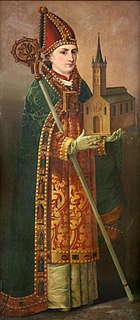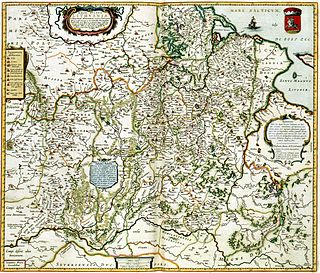
Saint Ansgar, also known as Anskar, Saint Anschar or Oscar, was Archbishop of Hamburg-Bremen in the northern part of the Kingdom of the East Franks. Ansgar became known as the "Apostle of the North" because of his travels and the See of Hamburg received the missionary mandate to bring Christianity to Northern Europe.

The Council of Constance is the 15th-century ecumenical council recognized by the Catholic Church, held from 1414 to 1418 in the Bishopric of Constance. The council ended the Western Schism by deposing or accepting the resignation of the remaining papal claimants and by electing Pope Martin V.

Huneric or Hunneric or Honeric was King of the Vandal Kingdom (477–484) and the oldest son of Genseric. He abandoned the imperial politics of his father and concentrated mainly on internal affairs. He was married to Eudocia, daughter of western Roman Emperor Valentinian III (419–455) and Licinia Eudoxia. The couple had one child, a son named Hilderic.
The Northern Crusades or Baltic Crusades were religious wars undertaken by Catholic Christian military orders and kingdoms, primarily against the pagan Baltic, Finnic and West Slavic peoples around the southern and eastern shores of the Baltic Sea, and to a lesser extent also against Orthodox Christian Slavs.

Saint Porphyry was bishop of Gaza from 395 to 420, known, from the account in his Life, for Christianizing the recalcitrant pagan city of Gaza, and demolishing its temples.

The Bank of Lithuania is the central bank of the Republic of Lithuania. The Bank of Lithuania is a member of the European System of Central Banks. The chairman of the bank is Vitas Vasiliauskas. Until 2015, the Bank of Lithuania was responsible for issuing the former Lithuanian currency, the litas.

Mikołaj Hussowczyk. Other name spelling variants include Hussoviensis, Hussovianus, Ussovius, Hussowski, Gusowski); was an early Renaissance poet and humanist of Grand Duchy of Lithuania, and cultural and social activist. His most notable work is Carmen de statura...bisontis.

Lithuanian Americans refers to American citizens and residents who are Lithuanian and were born in Lithuania, or are of Lithuanian descent. New Philadelphia, Pennsylvania has the largest percentage of Lithuanian Americans (20.8%) in the United States. Lithuanian Americans form by far the largest group within the Lithuanian diaspora.

Stanisław Łubieński, of Pomian coat of arms, was a Polish noble, politician and bishop. Royal Secretary of king Zygmunt III Waza from 1591; regent of Royal Chancellery from 1614, Crown Secretary, bishop of Łuck from 1622, Deputy Chancellor of the Crown from 1626 and bishop of Płock from 1627.

The Roman Catholic Metropolitan Archdiocese of Kaunas is a Latin archdiocese of the Roman Catholic Church in Lithuania.

Bandava - and old Curonian land which existed in the territory of the Latvia during the late iron age until it was conquered and divided in 1253 by Bishopric of Courland and Livonian Order.

Apuolė is a historic village in Skuodas district municipality, Lithuania. It is situated some 8 kilometres (5.0 mi) east of Skuodas on the banks of the Luoba River. It had a population of 132 according to the 2001 census and 119 according to the 2011 census. Having survived a viking attack in 854, Apuolė is the oldest Lithuanian settlement mentioned in written sources. Since 2004, the attack is commemorated by an annual medieval reenactment Apuolė 854.

Sigitas Tamkevičius is a Lithuanian prelate of the Roman Catholic Church and Archbishop emeritus of Kaunas.

The Blessed Vitas, O.P., or Wit was a Polish Dominican friar from the Kraków convent and the first bishop in Lithuania (1253–1255).

The Curonians or Kurs were a Baltic tribe living on the shores of the Baltic Sea in what are now the western parts of Latvia and Lithuania from the 5th to the 16th centuries, when they merged with other Baltic tribes. They gave their name to the region of Courland (Kurzeme), and they spoke the Old Curonian language. Curonian lands were conquered by the Livonian Order in 1266 and they eventually merged with other Baltic tribes participating in the ethnogenesis of Lithuanians and Latvians.

The history of Lithuania between 1219 and 1295 concerns the establishment and early history of the first Lithuanian state, the Grand Duchy of Lithuania. The beginning of the 13th century marks the end of the prehistory of Lithuania. From this point on the history of Lithuania is recorded in chronicles, treaties, and other written documents. In 1219, 21 Lithuanian dukes signed a peace treaty with Galicia–Volhynia. This event is widely accepted as the first proof that the Baltic tribes were uniting and consolidating. Despite continuous warfare with two Christian orders, the Livonian Order and the Teutonic Knights, the Grand Duchy of Lithuania was established and gained some control over the lands of Black Ruthenia, Polatsk, Minsk, and other territories east of modern-day Lithuania that had become weak and vulnerable after the collapse of Kievan Rus'.
Zacharias Ferreri or Ferrari (1479–1524) was an Italian monk and papal legate, Latin poet and ecclesiastical writer.

Juozas Vitas was a Lithuanian communist. In 1942–1943, he organized the anti-German resistance group, Union for the Liberation of Lithuania, and established contacts with Polish and Jewish underground. These activities were detected by the Gestapo and Vitas was executed. He was recognized as Hero of the Soviet Union in 1965. He was the seventh and last Lithuanian to receive Hero of the Soviet Union for anti-German resistance.
The Lithuanian order of precedence is a nominal and symbolic hierarchy of important positions within the Government of Lithuania. Administered by the Ministry of Foreign Affairs, the hierarchy does not determine the order of succession for the office of President of the Republic of Lithuania, which is instead specified by the Constitution of Lithuania.

















